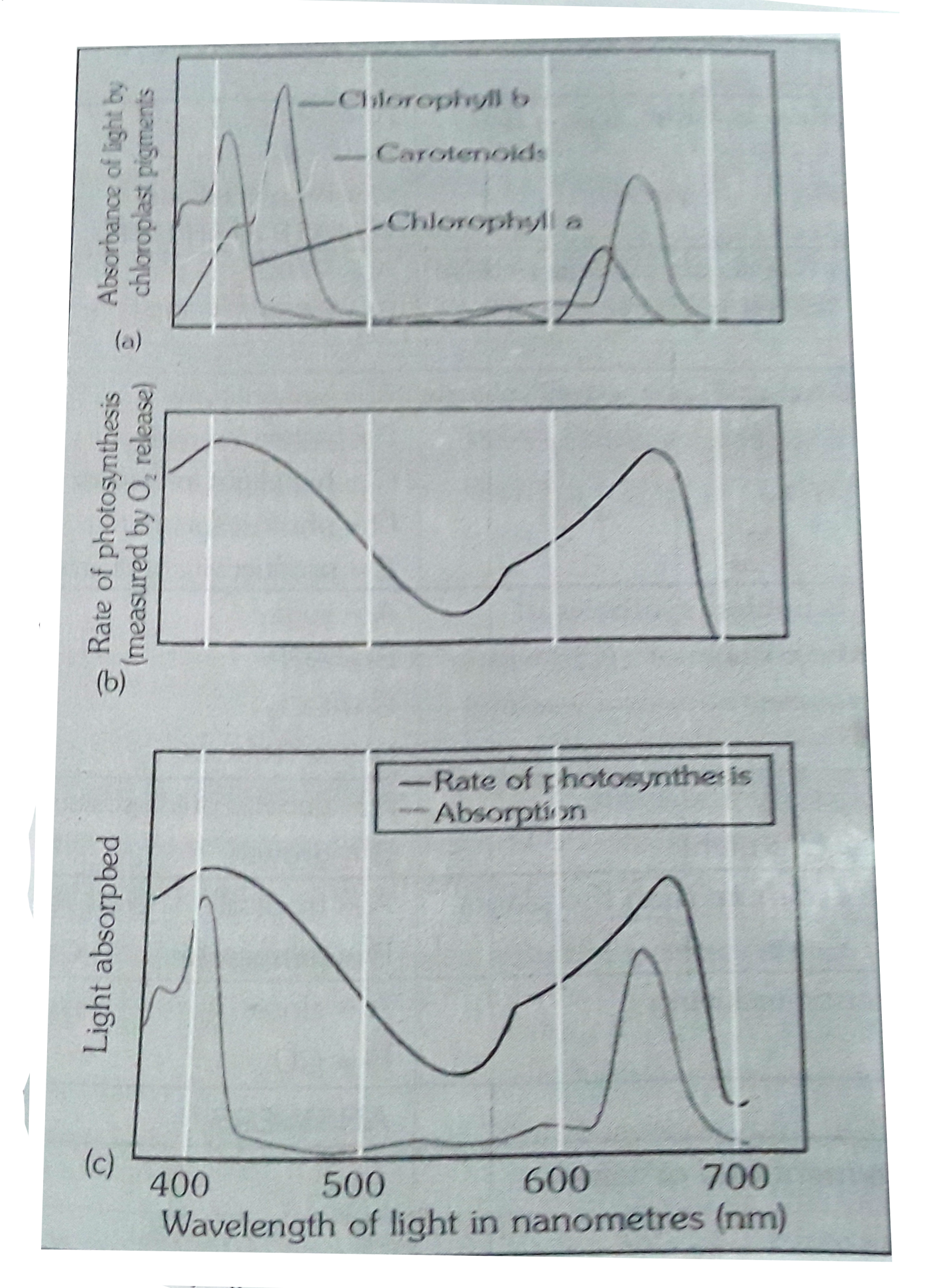In PS I the reaction centre chlorophyll a has an absorption peak at 700 nm, hence is called (A)____ while in PS II it has absorption maxima at 680 nm and is called (B)____
The correct Answer is:A=P700
B=P680
To answer the question regarding the absorption peaks of chlorophyll a in Photosystem I (PS I) and Photosystem II (PS II), we can break down the information step by step.
1. Understanding Photosystems:
- Photosystems are complexes in plants that play a crucial role in photosynthesis. They contain pigments that absorb light energy.
2. Identifying PS I:
- In Photosystem I, the reaction center chlorophyll a has an absorption peak at 700 nm. This specific chlorophyll a is designated as P700.
3. Identifying PS II:
- In Photosystem II, the reaction center chlorophyll a has an absorption peak at 680 nm. This chlorophyll a is designated as P680.
4. Filling in the Blanks:
- Based on the absorption peaks:
- (A) for PS I is P700.
- (B) for PS II is P680.
Final Answer:
(A) P700
(B) P680
---
- Photosystems are complexes in plants that play a crucial role in photosynthesis. They contain pigments that absorb light energy.
- In Photosystem I, the reaction center chlorophyll a has an absorption peak at 700 nm. This specific chlorophyll a is designated as P700.
- In Photosystem II, the reaction center chlorophyll a has an absorption peak at 680 nm. This chlorophyll a is designated as P680.
- Based on the absorption peaks:
- (A) for PS I is P700.
- (B) for PS II is P680.
(A) P700
(B) P680
Topper's Solved these Questions
- PHOTOSYNTHESIS IN HIGHER PLANTSBOOK - ALLENCHAPTER - PHOTOSYNTHESIS IN HIGHER PLANTSEXERCISE - True & False
6 Videos
- PHOTOSYNTHESIS IN HIGHER PLANTSBOOK - ALLENCHAPTER - PHOTOSYNTHESIS IN HIGHER PLANTSEXERCISE - Diagram Based Questions
4 Videos
- PHOTOSYNTHESIS IN HIGHER PLANTSBOOK - ALLENCHAPTER - PHOTOSYNTHESIS IN HIGHER PLANTSEXERCISE - Match the column
3 Videos
- ORIGIN & EVOLUTION OF LIFEBOOK - ALLENCHAPTER - ORIGIN & EVOLUTION OF LIFEEXERCISE - EXERCISE-IV (ASSERTION & REASON)
25 Videos
- PLANT DIVERSITY (Taxonomy to History of Taxonomy)BOOK - ALLENCHAPTER - PLANT DIVERSITY (Taxonomy to History of Taxonomy)EXERCISE - S
51 Videos
Similar Questions
Which of the following statements with regard to photosynthesis is/are correct?
I. In C3 plants, the primary CO2 acceptor is RuBP.
II. In the photosynthetic process, PS-II absorbs energy at or just below 680 nm.
III. The chlorophyll-a that is present in the photosystem-I has absorption maxima at 680nm.
View SolutionObserve the following graphs carefully and select the true or false statement regarding it:-

(i) Graph a indicates that at wavelength of blue and red color, chlorophyll a shows maximum absorption.
(ii) Graph b indicates that at wavelengths of blue and red color, plants shows maximum rate of photosynthesis.
(iii) Graph c indicates complete one to one overlap between the absorption spectrum of chlorophyll a and the action spectrum of photosynthesis.
View Solution
Knowledge Check
In PS I, the reaction centre chl a has absorption maxima at____whereas in PS II, the reaction centre Chl a has absorption maxima at ___
A700nm ,680nmB680nm,700nmC400nm,500nmD700nm,800nmReaction centre of PS I is ____ and reaction centre of PS II is___
AP680,P700BP700,P680CP800,P600DP700,P900Consider the following statements each with two blanks.
(A) Seminiferous tubules produce (i)_____ while Leydig's cells produce (ii)_____.
(B) In females, urethra is small and conducts (iii)_____ while in males it conducts urine and (vi)_____.
(C) The process of formation of spermatozoa form spermatogonia is called (v)_____ and the process of maturation of spermatids into spermatozoa is called (vi)_____.
Which one of the following options, gives the correct fill ups for the respective blanks numbers from (i) to (vi) in the statements?A(i)-spermatozoa, (ii)-testosterone,
(v)-spermatogenesis, (vi)-spermiogensisB(i)-testosterone, (ii)- spermatozoa,
(iii)-urine, (iv)-semenC(i)-estrogen, (ii)-testosterone,
(v)-spermiogenesis, (vi)-spermatogenesisD(iii)-urine, (iv)-semen,
(v)-spermiogenesis, (vi)-spermatogenesis
Pigment molecule present at reaction centre of PS-I and PS-II respectively are
View SolutionWhich of the following statement is / are incorrect ?
(i) Green light falling in the range of wavelength 500 -580 nm is least effective for photosynthesis.
(ii) In non - cyclic photophosphorylation, the electron expelled from the reaction centre is not cycled back , though its loos is compensated by electrons from the photolysis of water .
(iii) Chl a , Chl b , carotenoids , and xanthophylls are insoluble in organic solvents.
(iv) 400-700 nm light is used in photosynthesis also known as PAR.
(v) Red light is the most effective for photosynthesis.
View SolutionState which type of chemical reactions proceed with - a. Evolution of heat energy b. Absorption of heat energy. State in each of the following reactions whether heat is evolved or absorbed - i. Water is added to quicklime ii. Two neutral gases on passage through an electric arc give niric oxide iii. Two neutral gases combine to give - a basic gas.
View SolutionA double - slit apparatus is immersed in a liquid of refractive index 1.33 it has slit separation of 1mm and distance between the plane of slits and screen 1.33 m the slits are illuminated by a parallel beam of light whose wavelength in air is 800 nm.
(i) Calculate the fringe width.
(ii) One of the slits of apparatus is covered by a thin glass sheet of refractive index 1.53 Find the smallest thickness of the sheet to bring the adjacent minima on the axis.
View SolutionRead the following statement (P - T) and select the option that correctly fills (i) - (v)
P. The male frog has a special organ on the throat called I–
Q. ii–– membrane is a part of ear and serves to receive sound waves
R. Dermis of the frog contains sac-like iii–– glands
S. Tongue of frog is iv––
T . v–– respiration takes place in lungs on land.
View Solution
